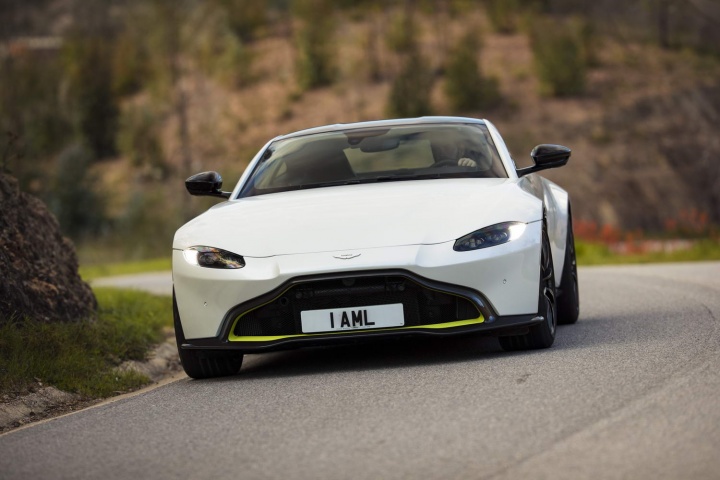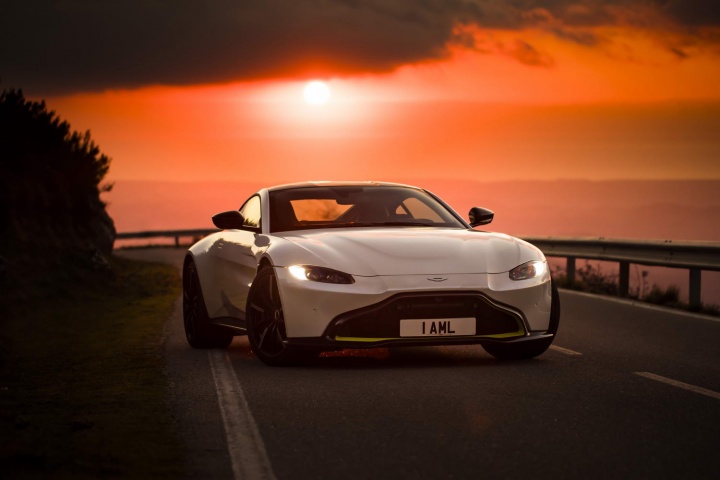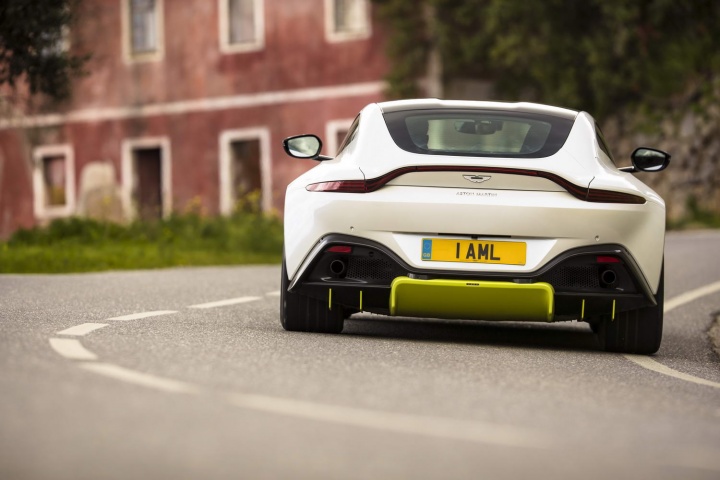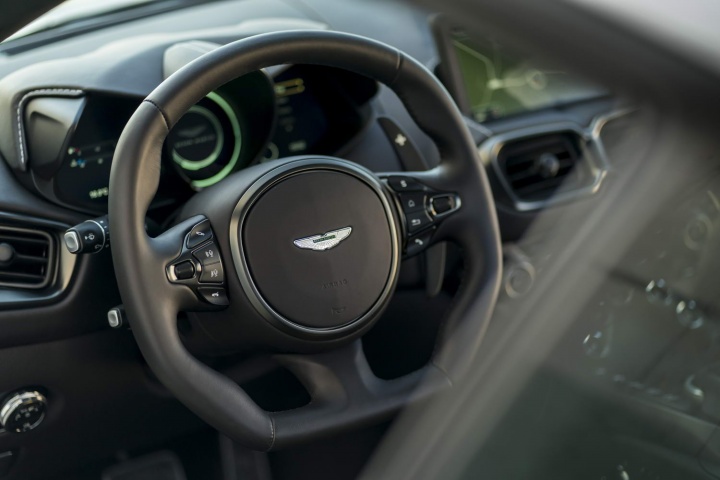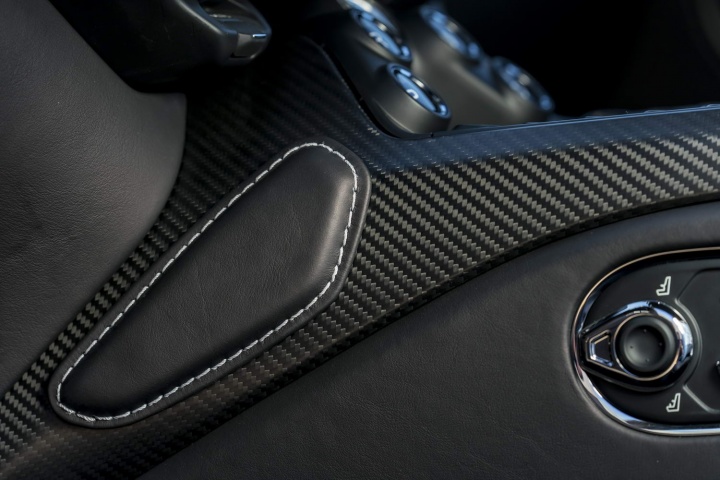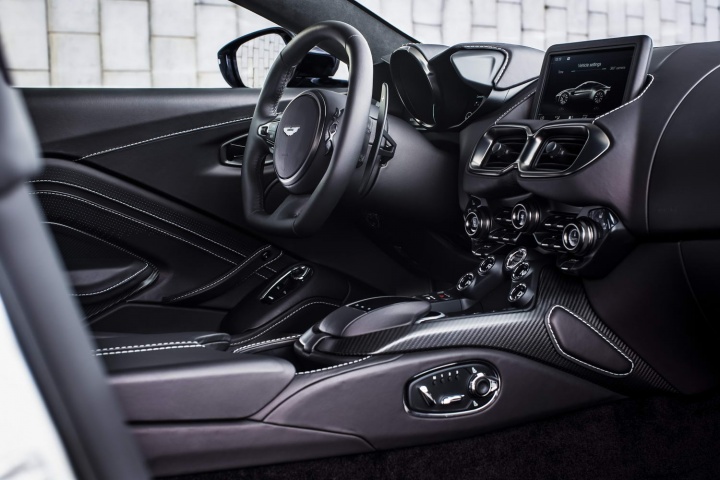Aston Martin means serious business with its brand-new Vantage coupe, giving the two-seat sports car an engaging and exciting chassis to match its AMG-sourced V8 engine and eye-catching styling, leaving you in no doubt that this is a car designed to be driven. We've done just that, on road and track. Still want a Porsche 911?
In the metal
There seems to be universal approval for the design of the rear of the new Aston Martin Vantage. The ultra-thin and curvy LED lights are complemented by an impossibly small separate fog light, and there's a stylishly integrated 'flip' spoiler, but your eyes can't help but be drawn to the extreme-looking diffuser, sucking the car down (visually and in actuality), giving it a spectacularly low and wide stance. Apparently, the flat floor underneath caused 'challenges' with manufacturing, but it all adds up to some 77kg of downforce at top speed at the back. And, well, it looks fab, doesn't it? Look closer and you'll spot a technical looking hexagonal mesh surrounding the exhaust outlets, which look surprisingly small. It's possible to upgrade to a dual-exit sports system.
A range of gorgeous 20-inch alloy rims are offered, wearing Pirelli P-Zero tyres, including a set of ultra-light forged wheels with a textured grey finish that really ramp up the aggressiveness of the design. That finish can be matched in the side gills, though they're functional too, relieving air pressure within the wheel wells. Take a closer look at the side glass and you'll see Aston's designers cleverly hid the window seals out of view, giving the Vantage a keenly modern and sleek appearance.
Which brings us to the front. The low nose was obviously inspired by the Aston DB10 concept (Bond's ride in Spectre), but the detailing is more defined, while the traditional Aston Martin grille is not. Instead, there's an emphasis on the integrated splitter and highly technical looking, yet very compact, all-LED lights. Miles Nurnberger likens the Vantage's shape to that of a hunter with its nose close to the ground sniffing for its prey, in contrast to the raised and possibly snooty nose of the more aloof DB11. Make of that what you will, but the Vantage certainly turns heads.
Aston has kept the wonderfully graceful 'swan's wing' door opening, which ever so subtly arcs up as well as out, allowing access to the two-seat cabin. There's far more space inside than in the old Vantage, so drivers of much larger stature will be able to get comfortable, helped by more adjustment of the seat and steering wheel than before, too. There's some stowage room behind the seats and a useful 350-litre boot behind accessed easily via the rear hatch.
Although the TFT instruments and the Daimler-sourced infotainment system are more or less the same as found in the Aston DB11, the Vantage has been given its own design of dashboard and seats. Even the paddles for the transmission are larger. The centre console is a little busy with buttons, but as many of them relate to tweaking the driving systems, we'll reserve criticism. Indeed, about the only negative thing to say about the cabin is that the buttons on the steering wheel feel fragile. Shame, as the trim materials used elsewhere, and the unique finishes offered, make the Vantage's interior distinctive and desirable.
Driving it
Our first experience at the wheel of the new Vantage was on the (wet, but drying) Portimao race track in Portugal. This is a serious circuit with blind crests, high-speed corners, a long straight and a few big braking zones. In short, not a place for an average road car. It would have been forgivable for Aston Martin to allow us a couple of fast laps, possibly behind a pace car, to give us a feel for the Vantage and leave it at that. But no, we were allowed two 20-minute stints, virtually unhindered. Yes, the track cars all featured the optional carbon ceramic brakes, lighter wheels and sports exhaust, but that was it.
At the centre of the experience is, of course, the twin-turbocharged 4.0-litre V8 petrol engine, borrowed from AMG. It sounds quite different in the Vantage (in comparison to its Mercedes-AMG GT home) due to Aston's own fettling and installation, but it kicks just as hard, with up to 510hp and 685Nm of torque. That maximum torque output is available from just 2,000rpm as well so it's effectively always on tap, giving the Vantage effortless and meaningful acceleration regardless of what the rev counter is showing. If you have space to hold the accelerator pedal all the way down for any length of time, then the Vantage is effectively supercar-fast. It certainly never feels overwhelmed by the wide expanses of race tarmac at our disposal, savagely accelerating along the main straight for the first turn and hitting over 240km/h before you need to brake hard.
Even if you end up braking while not completely straight the Vantage turns out to be very stable and that's how I'd describe it through fast corners too. And yet, that's not at the expense of driver interaction, as the chassis is playful and mobile when you want it to be. Front-end grip is strong and dependable into and through a corner and then it's up to you how you want the rear to behave. Keep it neat and tidy and you'll feel the new electronically controlled rear differential hook up on the exit of a corner and help fire the car out in a deliciously rear-led stance, keeping within the bounds of grip. Push further and the ESC stability control cuts in quickly. This is fine for public road use, but on track it makes the Vantage feel less natural to drive, but thankfully there's a middle setting that allows a lot more slip before intervening.
Obviously, we wouldn't be doing our jobs if we didn't see what would happen with the ESC turned off, and there's little to fear in the dry as mechanical grip is so high. However, if you seek out the limits, the Vantage reveals that, beyond its initial loss of traction, the rear starts to slide sideways very quickly indeed, and it takes quick reactions (or a lot of practise...) to keep things smooth and prevent a spin. Huge fun on a wide track, but not recommended on the road.
And while many Vantage buyers may seek out the occasional track outing, the majority are likely to stick to the road and drive well within the car's high limits. Thankfully, the Vantage is just as at home there, though the raucous engine and its formidable performance is always a mere ankle flex away from licence-losing speed. Speaking of which, the car's Track mode makes the throttle response a little too edgy for pootling around, but I guess the clue is in the name.
Sensibly, Aston has separated the car's main driving modes (Sport, Sport+ and Track) from the adaptive damper settings, so the driver can optimise the set-up for any given road. There's no doubt that the suspension is firm, but it's so well controlled that you'd stop short of calling it uncomfortable. Indeed, the only thing preventing the Vantage from being as good a long-distance cruiser as the Aston DB11 is the extra road noise that makes its way through to the cabin.
Best then to take the long and twisty way around whenever possible. For now, the only gearbox is an eight-speed automatic (Aston has confirmed that a seven-speed manual is on the way), but it's brilliantly judged, managing soft and smooth automatic shifts when you want to take your time or full-on aggressive gear changes and quick reaction to the paddles (accompanied by satisfyingly gratuitous throttle blips on down-shifts of course) in the sportier settings. This is a car you will change gear in just for the sake of it, to hear that V8 at work.
Find a fiendishly twisty road and the Vantage comes alive, scything from corner to corner with rock solid body control, composure and quick-witted power steering. The latter is direct, feels completely free of slop and does a good job of telling you what's happening at the interface of tyre and road. What more could you want from your sports car?
What you get for your money
It's not easy to find directly comparable cars to the Aston Martin Vantage. We were told that the Porsche 911 GTS was used as a benchmark, but Aston clearly veered further away from the GT, everyday use aspect in return for more excitement and driver engagement. And yet it's not as track-focused as the 911 GT3, for example. What's more, it doesn't have the (occasional) rear seats of the regular 911s. The Jaguar F-Type is the closest thing there is in terms of concept, with a wider range of options, but it's not as special, while the Audi R8 is a completely different prospect for similar money. Needless to say, if you're buying a car at this level, the entry-level price is of little importance, and while the Vantage is adequately equipped as standard, buyers can spend a lot more on personalising it.
Summary
Aston Martin has created a dramatically exciting car, replacing the much-loved and charismatic old Vantage with a far more technically accomplished vehicle. And yet, despite all its modernisation, the new Vantage has far more personality and drips with seduction in a way its rivals can only hope for. Given that this coupe is only the starting point in the new Vantage story, it bodes well for the company's fortunes.

























